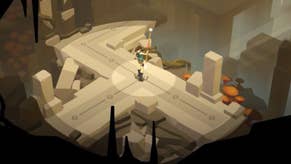Lara Croft Go reveals what Tomb Raider's been missing
Boulder and wiser.
Tomb Raider's identity crisis has been fascinating to watch. For the last few years, there have been two Lara Crofts at work: the first of them trying to humanise the video game icon one gruesome injury or base camp bunkdown at a time, the other blissfully free of most mortal concerns, twin-pistol blasting an arcadey path through isometric ruins, often with a co-op partner in tow.
Both of these Laras, however, are results of a crucial decision made early on in the design process: the big budget reboot and the Guardian of Light series fundamentally agree when they envision Tomb Raider as an action game above almost all else. And now Lara Croft Go is here, in its soothing, semi-cerebral way, to say that there is much more to it than that. Or perhaps much less.
The old Tomb Raiders have always been surprisingly terrible at action, in fact. The Core games offered the occasional bullet-sponge enemy to pop away at - they were more than occasional in Tomb Raider 2 - but these moments always felt like the designers were paying lip-service to the sort of things that people expected from games. The heart wasn't in it, and so Tomb Raider enemies did stupid things. They would run in circles for no reason, or get themselves trapped on odd pieces of geometry. And while you may remember the T-Rex reveal back in the glory days of PlayStation One, how much can you really recall about the fight that followed? Actually, for that matter, was there a fight that followed?

Lara Craft Go is not an action game. It's a turn-based puzzle game in the spirit, if not the style, of Hitman Go. In truth, it isn't quite as clean: the neat board game aesthetic has been ditched, and Lara's world does not make as much sense rendered in clockwork as Agent 47's did. Still, it feels like this latest lunge at the character comes closer to hitting the mark than her recent adventures, for all the skill and spectacle with which they're delivered. Lara Croft Go reveals a little of what Tomb Raider's been missing of late.
And that's loneliness: solitude, "the state of being unfrequented by human beings". Go's pared-back maps unfold in crumbling temples far beyond the reach of man, and there isn't a co-op partner or a handy piece of cover in sight. This isn't exploration as such - you swipe to move down a fairly rigid path - but the whole thing buzzes with the same gentle brain-teasing background noise of the early Tomb Raiders nonetheless. There's combat, but combat's a puzzle here, as you work out how to tackle enemies who all use space in a different way: snakes who can only be killed by approaching from the rear or the side, spiders who follow a set path back and forth, lizards who pursue you with real precision, trailing you step for step - with potentially useful consequences.
Everything else is a puzzle, too, and the game's familiar returning faces aren't cherished cast members or fan favourite villains, because Tomb Raider's never really had either. Instead, they're furniture: pressure plates, buzz-saws, levers that move platforms about. After a slow, rather plodding opening section, these come together with the mechanical menagerie to create some lovely challenges. One sees you coaxing a saw through rows of oblivious snakes, shifting it between one track and the next like a signalman. Another offers the almost comical prospect of a turn-based boulder chase. A turn-based boulder chase! It works, and it's also strangely charming, a transposition of temperament that reminds you how satisfying Tomb Raider's ability to rework matinee idol set-pieces can be.
Retooled as it is, then, Lara Croft Go feels like a throwback, from the fact that you can still pull off the classic handstand move when hefting yourself up over a ledge, through to the use of the old rotating graphical menu when loading a game. It's not the complete Tomb Raider experience, and yet this playful offshoot suggests that a heroine who spends so much time exploring the past may just have stumbled on a crucial chunk of her own history.












